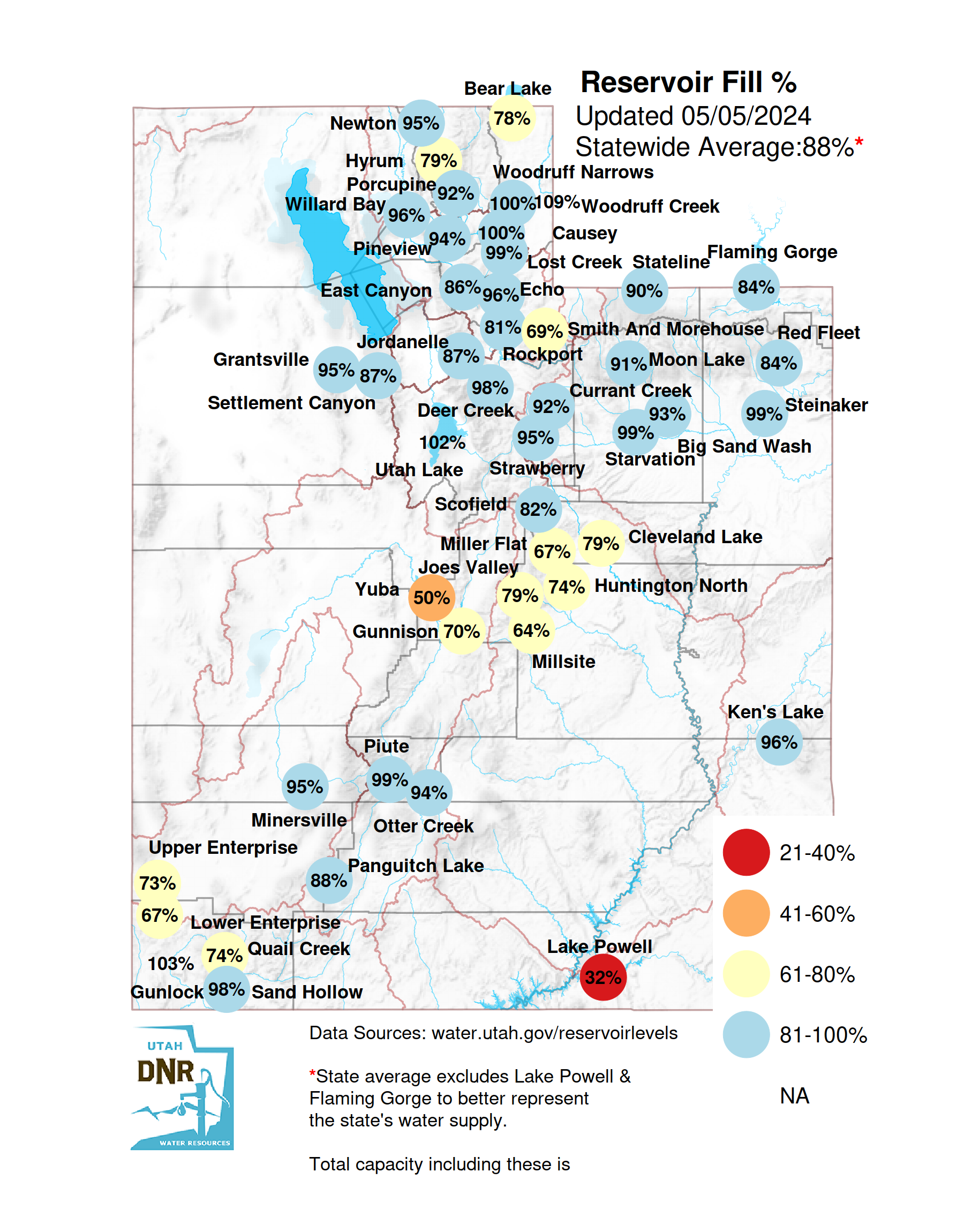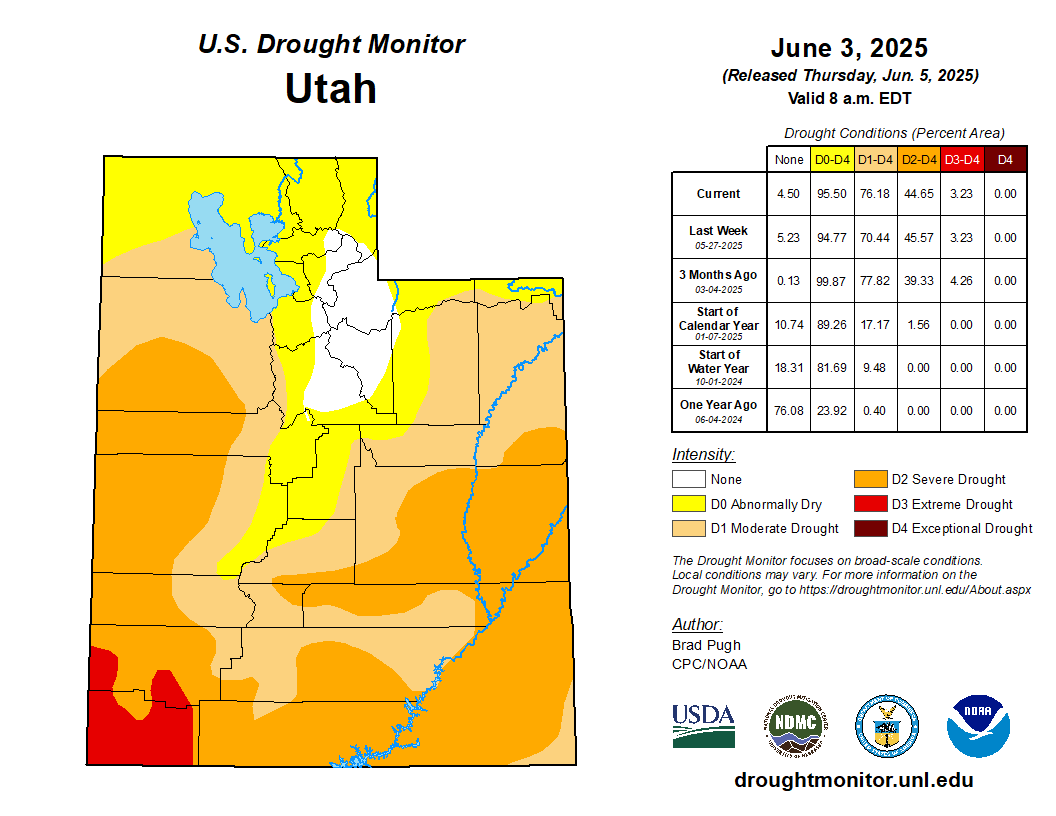Thank you to all who are doing their part to save water! Last summer, Utahns responded to the call to conserve and reduced their water use, saving billions of gallons. We can do it again. Those who are making efforts today are saving water for our tomorrow.
As spring runoff dwindles, Utah begins its drying period
Utah has been in drought eight of the last 10 years, and this year’s dismal snowpack isn’t enough to end it. Snowpack was 25% below normal and peaked almost two weeks early. Reservoir storage is what gets us through the dry years and is dependent on snowpack and runoff. But extended drought and last year’s hot, dry conditions have really drained our reservoirs. We don’t know how long this drought will last. That’s out of our control. But what is in our control is how we respond. All Utahns across all sectors need to use less water and look for ways to use this critical resource more efficiently.
Drought Update (06/09/22)
- 5.71% of the state is now in exceptional drought (the worst category) and 99.88% of the state in severe drought.
- Statewide snow water equivalent (SWE), or how much water would be in the snowpack if it melted, peaked at 12 inches. This is 75% of the typical median peak of 16 inches for our water year.
- Thirteen of Utah’s largest 45 reservoirs are below 55% of available capacity. Overall statewide storage is 63% of capacity. This time last year, reservoirs were about 67% of capacity.
- Of the 99 measured streams, 61 are flowing below normal despite spring runoff. Four streams are flowing at record low conditions.
- Weber Basin Water Conservancy District has received very little new storage during the last two years and is expected to receive very little again this year. To mitigate the effects of the drought on their storage reservoirs, they have reduced the amount of water they intend to deliver to contract holders this year. They are also purchasing 5,000 acre-feet of Echo shares from users on the Provo River and about 14,000 acre-feet from Deer Creek water users. The delivery of this water into Weber Basin’s reservoirs will be accomplished by modifying the operation of the Weber-Provo Canal.
Look for Water-Saving Opportunities
Now is the time to look for indoor water-saving water-saving opportunities.
For drought-related questions, please email drought@utah.gov.
What Is Drought?
Drought is a normal and recurring climate feature. Although it occurs in virtually all of the world’s climatic zones, its characteristics vary significantly from one region to another. Consequently, there is no universal drought definition. In general, drought is a result of a deficiency of precipitation over an extended period of time, resulting in a water shortage, which impacts normal water usage. The severity of a drought depends upon the degree of moisture deficiency, its duration, and the size of the affected area. Because it is so hard to develop a quantitative definition for drought, it is difficult to determine precisely when a drought starts and ends.
In the United States, droughts are among the most financially burdensome of all weather-related disasters. In fact, in the 20 years preceding hurricane Katrina, the single largest U.S. weather-related disaster was the drought of 1988, which resulted in over $40 billion in damages throughout the central and northeastern portions of the country. Unlike impacts from floods, hurricanes, tornados or other weather-related disasters, drought impacts are not always immediate. Failed crops can impact food prices well into the future. Devastated domestic livestock and wildlife herds can also take many years to recover.
Managing Drought
Drought should not be viewed as merely a natural phenomenon or event. Its impact on society is often a result of the interplay between the natural event (reduced precipitation) and the way society responds with the management of existing supplies. People often compound the impacts of drought through the mismanagement of available supplies. One example of this occurs when outdoor watering restrictions imposed by community leadership are actually perceived by the general public as being premature or unnecessary. Often in these instances, while people comply with the letter of the law, water use actually rises. Consequently, an informed and caring general public is an important ingredient to successful drought management.
Utah’s successful drought management will in large part be a function of leadership providing the necessary information to the public, and people, in turn, responding positively. Utah’s current Drought Response plan was written during the drought of the late ’80s and early ’90s. The plan uses the Surface Water Supply Index (SWSI) to describes five drought conditions. The SWSI is a relative scale with 0 representing average conditions. A positive number indicates that water supplies are above normal, while a negative number indicates that water supplies are below normal.
The first condition, Normal to wet, is really a non-drought condition and the plan merely calls for the periodic updating of SWSI data and maps. When the SWSI moves into the 0 to -1.0 range, conditions are still considered normal, with water supplies only slightly below average. Although this is not a true drought condition it is called “Emerging Drought” in the plan, primarily because of the potential for worsening conditions. During this phase, the plan merely calls for increased monitoring of data. When the SWSI moves below -1.0, the condition is a Phase I Drought. At this point, the state’s Water Supply and Availability Committee is activated and begins to closely monitor water supply data and initiates the dissemination of information to the media and general public. When the SWSI moves below -2.0, it is a Phase II drought condition. At this time, a Drought Review and Reporting Committee and Drought task force are created with members of various state agencies to coordinate drought response actions and facilitate the timely dissemination of data and information. The Governor’s Proclamation of Drought Emergency, rather than a SWSI number, triggers drought Phase III. The Governor’s declaration of drought emergency is the initial and necessary step to make available many of the state and federal drought assistance programs.
Measuring Drought
The U.S. Drought Monitor is a broad-scale national drought map. It is updated weekly and communicates any unusually dry conditions with 4 drought categories (moderate, severe, extreme, and exceptional drought) and an “abnormally dry” category, indicating areas that may be moving into or out of drought. These categories correspond to percentiles of different data (exceptional 0-2, extreme 3-5, severe 5-10, moderate 11-20, abnormal dryness 21-30), with the lower percentile numbers meaning drier conditions.
Different data that account for precipitation over multiple time scales, streamflow, groundwater, soil moisture, and other meteorological and hydrological variables, are placed into percentiles for different locations. Often, the different data will not all indicate the same drought category for a particular location. The author of that week’s map looks at all of this information and assigns a category to an area based on what percentile range the different indicators and indices converge on.
Since the U.S. Drought Monitor map is intended to show the entire nation, local conditions may vary from the categories shown on the map. Here in Utah, we rely upon snowmelt runoff stored in reservoirs to get through the hot summer irrigation season. If enough snow falls in the mountains during the winter months, dry summer weather conditions can be somewhat overcome in many areas of the state. While the U.S. Drought Monitor is a useful tool with many applications, the Surface Water Supply Index (SWSI) is used to monitor drought status. The SWSI compares gauged streamflow and current reservoir storage with average streamflow and reservoir storage conditions. This comparison provides us with a more accurate assessment of our ability to deal with the drought situation indicated by the U.S. Drought Monitor map.
Drought Webinars
Drought webinars are held on a regular basis to collect feedback on weather conditions around the state. The webinars are hosted by a committee headed by the Division of Water Resources, the Utah Department of Agriculture and Food, and the Utah Climate Center. For more information on drought webinars, email drought@utah.gov.
Webinar Schedule
The next webinar is scheduled for May 24, 2022 at 1pm MT. (Webinars are typically scheduled on Tuesdays and are usually held every two weeks.)
Past Utah Drought Webinar Presentations
- May 10, 2022
- April 19, 2022
- March 29, 2022
- March 8, 2022
- February 22, 2022
- February 8, 2022
- January 25, 2022
- January 11, 2022
- View More . . .
Community Collaborative Rain, Hail and Snow Network
You can also participate in the Community Collaborative Rain, Hail and Snow Network. This group is a unique, non-profit, community-based network of volunteers of all ages and backgrounds working together to measure and map precipitation. CoCoRaHS is run by the Utah Climate Center. For more information visit www.cocorahs.org
Additional Resources
- NRCS Snow Survey
- NRCS Drought Webpage
- Drought Response Plan (Revised 2013)
- Draft Drought Response Plan (Updated 2022)
- State Hazard Mitigation Plan
- United States Geological Survey
- U.S. Drought Monitor
- National Integrated Drought Information Center
- Colorado River Basin Forecast Center
- Intermountain West Climate Dashboard
- Slow the Flow Website
- Conserve Water Website


